STIHL HL 90 K Instruction Manual
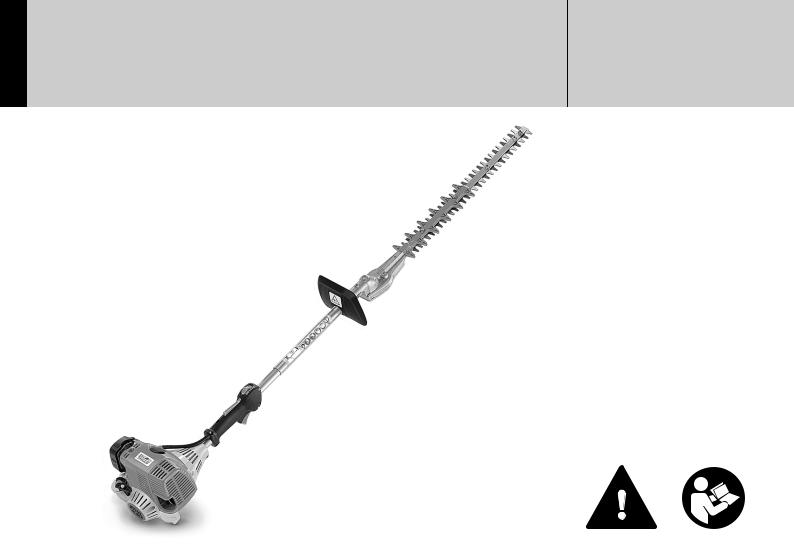
{
STIHL HL 90
Instruction Manual
Manual de instrucciones
 WARNING
WARNING
Read and follow all safety precautions in Instruction Manual – improper use can cause serious or fatal injury.
 ADVERTENCIA
ADVERTENCIA
Lea y siga todas las precauciones de seguridad dadas en el manual de instrucciones – el uso incorrecto puede causar lesiones graves o mortales.
Instruction Manual 1 - 38
Manual de instrucciones 39 - 80
English
Contents
Printing inks contain vegetable oils, paper can be recycled.
Printed on chlorine-free paper Original Instruction Manual
© ANDREAS STIHL AG & Co. KG, 2013 0458-445-8621-C. VA3.H13. 0000000917_008_GB
Guide to Using this Manual |
2 |
STIHL Incorporated California |
Safety Precautions and Working |
|
Exhaust and Evaporative |
Techniques |
2 |
Emissions Control Warranty |
Using the Unit |
12 |
Statement |
Mounting the Gearbox |
13 |
Trademarks |
Adjusting the Throttle Cable |
13 |
|
4-MIX Engine |
14 |
|
Fuel |
14 |
|
Fueling |
15 |
|
Starting / Stopping the Engine |
17 |
|
Operating Instructions |
19 |
|
Cleaning the Air Filter |
19 |
|
Engine Management |
20 |
|
Adjusting the Carburetor |
20 |
|
Spark Arresting Screen in Muffler |
22 |
|
Spark Plug |
23 |
|
Lubricating the Gearbox |
24 |
|
Replacing the Starter Rope and |
|
|
Rewind Spring |
24 |
|
Sharpening Instructions |
27 |
|
Storing the Machine |
27 |
|
Maintenance and Care |
28 |
|
Main Parts |
30 |
|
Specifications |
31 |
|
Special Accessories |
32 |
|
Maintenance and Repairs |
33 |
|
Disposal |
33 |
|
STIHL Incorporated Federal |
|
|
Emission Control Warranty |
|
|
Statement |
33 |
|
|
Allowonlypersonswhofullyunderstand |
|
this manual to operate your hedge |
|
cutter. |
35 |
To receive maximum performance and |
38satisfaction from your STIHL hedge cutter, it is important that you read, understand and follow the safety precautions and the operating and maintenance instructions in chapter "Safety Precautions and Working Techniques" before using your hedge cutter. For further information you can go to www.stihlusa.com.
Contactyour STIHLdealer or theSTIHL distributor for your area if you do not understandanyoftheinstructionsinthis manual.
 WARNING
WARNING
Because a hedge cutter is a high-speed cutting tool some special safety precautionsmustbeobservedtoreduce the risk of personal injury. Careless or improperusemaycauseseriousoreven fatal injury.
{This instruction manual is protected by copyright. All rights reserved, especially the rights to reproduce, translate and process with electronic systems.
HL 90 K |
1 |
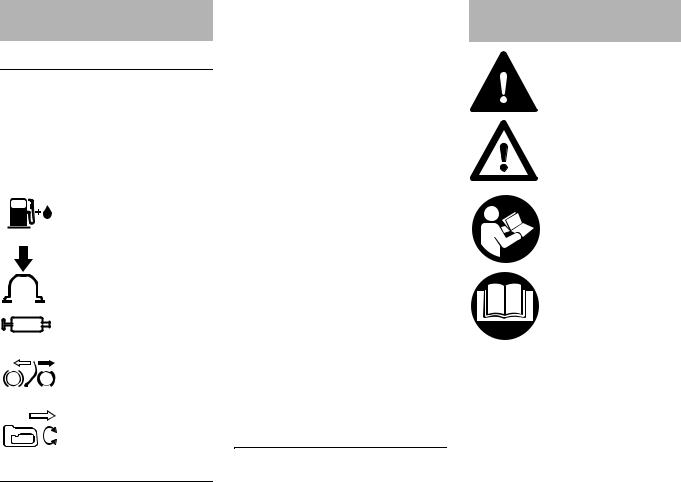
English
Guide to Using this Manual
Pictograms
The meanings of the pictograms attached to or embossed on the machine are explained in this manual.
Dependingonthemodelconcerned,the following pictograms may be on your machine.
Fuel tank for gasoline and engine oil mixture
Press to operate manual fuel pump
Filler hole for gear lubricant
Starting lock
Rotating rear handle
Symbols in Text
Many operating and safety instructions are supported by illustrations.
The individual steps or procedures describedinthe manualmaybe marked in different ways:
N A bullet marks a step or procedure.
2
A description of a step or procedure that refers directly to an illustration may contain item numbers that appear in the illustration. Example:
N Loosen the screw (1). N Lever (2) ...
In addition to the operating instructions, this manual may contain paragraphs that require your special attention. Such paragraphs are marked with the symbols and signal words described below:
 DANGER
DANGER
Indicates an imminent risk of severe or fatal injury.
 WARNING
WARNING
Indicates a hazardous situation which, if not avoided, could result in severe or fatal injury.
NOTICE
Indicates a risk of property damage, including damage to the machine or its individual components.
Engineering Improvements
STIHL’s philosophy is to continually improve all of its products. As a result, engineeringchangesandimprovements are made from time to time. Therefore, some changes, modifications and improvements may not be covered in this manual. If the operating characteristics or the appearance of your machine differs from those describedinthismanual,pleasecontact your STIHL dealer for assistance.
Safety Precautions and
Working Techniques
Because a hedge trim- mer is a high-speed, fastcutting power tool with sharp cutting blades, special safety precau- tions must be observed to reduce the risk of per- sonal injury.
It is important that you read, fully understand and observe the following safety precautions and warnings. Read the instruction manual and the safety precautions periodically. Careless or improper use may cause serious or fatal injury.
Have your STIHL dealer show you how to operate your power tool. Observe all applicable local safety regulations, standards and ordinances.
 WARNING
WARNING
Do not lend or rent your power tool without the instruction manual. Be sure that anyone using it understands the information contained in this manual.
 WARNING
WARNING
The use of this machine may be hazardous. If the cutting tool comes in contact with your body, it will cut you.
HL 90 K

Use your hedge trimmer only for cutting hedges, shrubs, scrub, bushes and similar material.
 WARNING
WARNING
Do not use it for other purposes, since misuse may result in personal injury or property damage, including damage to the machine.
 WARNING
WARNING
Minors should never be allowed to use this power tool. Bystanders, especially children, and animals should not be allowed in the area where it is in use.
 WARNING
WARNING
Toreducetheriskofinjurytobystanders and damage to property, never let your power tool run unattended. When it is not in use (e. g. during a work break), shut it off and make sure that unauthorized persons do not use it.
Most of these safety precautions and warnings apply to the use of all STIHL hedge trimmers. Different models may have different parts and controls. See the appropriate section of your instruction manual for a description of the controls andthe functionoftheparts of your model.
Safe use of a hedge trimmer involves
1.the operator
2.the power tool
3.the use of the power tool.
HL 90 K
THE OPERATOR
Physical Condition
You must be in good physical condition and mental health and not under the influence of any substance (drugs, alcohol, etc.) which might impair vision, dexterity or judgment. Do not operate this machine when you are fatigued.
 WARNING
WARNING
Be alert – if you get tired, take a break. Tiredness may result in loss of control. Working with any power tool can be strenuous.Ifyouhaveanyconditionthat mightbeaggravatedbystrenuouswork, check with your doctor before operating this machine.
 WARNING
WARNING
Prolonged use of a power tool (or other machines) exposing the operator to vibrations may produce whitefinger disease (Raynaud's phenomenon) or carpal tunnel syndrome.
These conditions reduce the hand's ability to feel and regulate temperature, produce numbness and burning sensations and may cause nerve and circulation damage and tissue necrosis.
All factors which contribute to whitefinger disease are not known, but cold weather, smoking and diseases or physical conditions that affect blood vessels and blood transport, as well as high vibration levels and long periods of
English
exposure to vibration are mentioned as factorsinthedevelopmentofwhitefinger disease. In order to reduce the risk of whitefinger disease and carpal tunnel syndrome, please note the following:
–Most STIHL power tools are available with an anti-vibration ("AV") system designed to reduce the transmission of vibrations created by the machine to the operator's hands. An AV system is recommended for those persons using power tools on a regular or sustained basis.
–Wear gloves and keep your hands warm.
–Keep the AV system well maintained. A power tool with loose components or with damaged or worn AV elements will tend to have higher vibration levels.
–Maintain a firm grip at all times, but do not squeeze the handles with constant, excessive pressure. Take frequent breaks.
All the above-mentioned precautions do not guarantee that you will not sustain whitefinger disease or carpal tunnel syndrome. Therefore, continual and regular users should closely monitor the condition of their hands and fingers. If any of the above symptoms appear, seek medical advice immediately.
 WARNING
WARNING
The ignition system of the STIHL unit produces an electromagnetic field of a very low intensity. This field may interfere with some pacemakers. To reduce the risk of serious or fatal injury, persons with a pacemaker should
3
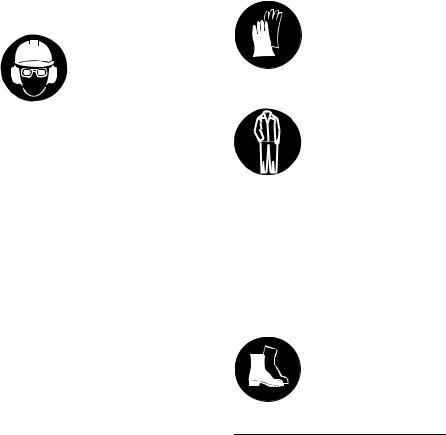
English
consult their physician and the pacemaker manufacturer before operating this tool.
Proper Clothing
 WARNING
WARNING
To reduce the risk of injury, the operator should wear proper protective apparel.
 WARNING
WARNING
To reduce the risk of injury to your eyes never operate your power tool unless wearing goggles
or properly fitted protec- tive glasses with adequate top and side protection complying with ANSI Z 87.1 (or your applicable national stand- ard). To reduce the risk of injury to your face STIHL recommends that you also wear a face shield or face screen over your goggles or protective glasses.
Wear an approved safety hard hat to reduce the risk of injury to your head when there is a danger of head injuries.
Power tool noise may damage your hearing. Wear sound barriers (ear plugs or ear mufflers) to protect your hearing. Continual and regular users should have their hearing checked regularly.
Be particularly alert and cautious when wearing hearing protection because your ability to hear warnings (shouts, alarms, etc.) is restricted.
Always wear gloves when handling the machine and the cutting tool. Heavy-duty, nonslip gloves improve your grip and help to protect your hands.
Clothing must be sturdy and snug-fitting, but allow
complete freedom of movement. Wear long pants made of heavy material to help protect your legs. Do not wear shorts, sandals or go barefoot.
Avoid loose-fitting jackets, scarfs, neckties, jewelry, flared or cuffed pants, unconfined long hair or anything that could become caught on branches, brush or the moving parts of the unit. Secure hair so it is above shoulder level.
Good footing is very important. Wear sturdy boots with nonslip soles. Steel-toed safety boots are recommended.
THE POWER TOOL
For illustrations and definitions of the power tool parts see the chapter on "Main Parts."
 WARNING
WARNING
Nevermodifythispowertoolinanyway. Only attachments supplied by STIHL or expressly approved by STIHL for use with the specific STIHL model are authorized. Although certain
4 |
HL 90 K |
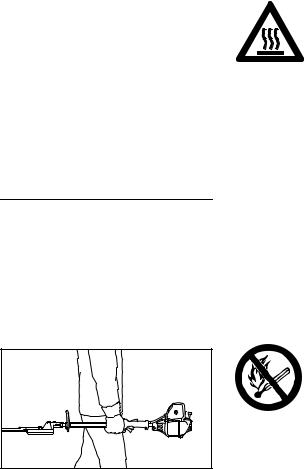
unauthorized attachments are useable with STIHL power tools, their use may, in fact, be extremely dangerous.
If this tool is subjected to unusually high loadsforwhichitwasnotdesigned(e. g. heavy impact or a fall), always check that it is in good condition before continuingwork.Checkinparticularthat the fuel system is tight (no leaks) and that the controls and safety devices are working properly. Do not continue operating this machine if it is damaged. Incaseofdoubt,haveitcheckedbyyour STIHL servicing dealer.
THE USE OF THE POWER TOOL
Transporting the Power Tool
 WARNING
WARNING
To reduce the risk of injury from blade contact, never carry or transport your power tool with the cutter blades moving.
002BA247 KN |
It may be carried only in a horizontal position. Grip the shaft in a manner that the machine is balanced horizontally. Keep the hot muffler away from your body and the cutting attachment behind you.
 WARNING
WARNING
To reduce the risk of burn injury, do not touch hot parts of the machine and the gear housing when they are hot.
 WARNING
WARNING
Always switch off the engine and fit the scabbard over the cutter blades before transporting the power tool over long distances. When transporting it in a vehicle, properly secure it to prevent turnover, fuel spillage and damage to the unit.
Fuel
Your STIHL power tool uses an oilgasoline mixture for fuel (see the chapter on “Fuel” of your instruction manual).
 WARNING
WARNING
Gasoline is an extremely flammable fuel. If spilled and ignited by a spark or other ignition source, it can cause fire and seri-
ous burn injury or property damage. Use extreme caution when handling gasoline or fuel mix. Do not smoke or bring any fire or flame near the fuel or the power tool. Note that combusti- ble fuel vapor may escape from the fuel system.
English
Fueling Instructions
 WARNING
WARNING
To reduce the risk of serious injury from burns, never attempt to refuel the unit until it has been completely removed from the operator.
 WARNING
WARNING
Fuel your power tool in well-ventilated areas, outdoors. Always shut off the engine and allow it to cool before refueling. Gasoline vapor pressure may build up inside the fuel tank depending on the fuel used, the weather conditions and the tank venting system.
In order to reduce the risk of burns and other personal injury from escaping gas vapor and fumes, remove the fuel filler cap onyour power toolcarefullysoas to allow any pressure build-up in the tank toreleaseslowly. Never remove thefuel filler cap while the engine is running.
Selectbaregroundforfueling andmove at least 10 feet (3 m) from the fueling spot before starting the engine. Wipe off any spilled fuel before starting your machine.
HL 90 K |
5 |
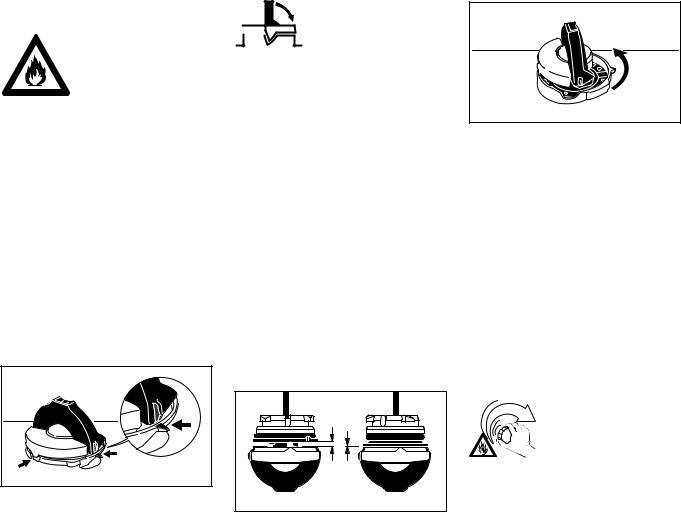
English
 WARNING
WARNING
Check for fuel leakage while refueling and during operation. If fuel leakage is found, do not start or run the engine until the leak is fixed and any spilled fuel has been wiped away. Take care not to get fuel on your clothing. If this happens, change your clothing immediately.
 WARNING
WARNING
Inordertoreducetheriskoffuelspillage and fire from an improperly tightened fuel cap, correctly position and tighten the fuel cap in the fuel tank opening.
Different models may be equipped with different fuel caps.
Toolless cap with grip
001BA220 KN
To do this with this STIHL cap, raise the griponthetopofthecapuntilitisupright at a 90° angle. Insert the cap in the fuel tank opening with the raised positioning marks on the grip of the cap and on the fuel tank opening lining up. Using the grip, press the cap down firmly while turning it clockwise as far as it will go (approx. 1/4 turn).
6
Fold the grip flush with the top of the cap. Grip 



 the cap and check for tightness. If the grip does not lie completely flush
the cap and check for tightness. If the grip does not lie completely flush
with the cap and the detent on the grip does not fit in the correspond- ing recess in the filler opening, or if the cap is loose in the filler opening, the cap is not properly seated and tightened and you must repeat the above steps.
Misaligned, damaged or broken cap
NIfthecapdoesnotdropfullyintothe openingwhenthepositioningmarks line up and/or if the cap does not tighten properly when twisted, the baseofthecapmaybeprematurely rotated (vis-à-vis the top) to the closed position. Such misalignment can result from handling, cleaning or an improper attempt at tightening.
001BA227 KN |
Left: |
Base of cap in closed posi- |
|
tion (with open space) |
Right: |
Base of cap correctly posi- |
|
tioned for installation |
001BA226 KN |
NTo return the cap to the open position for installation, turn the cap (with the grip up) until it drops fully intothetankopening.Next,twistthe capcounterclockwiseasfarasitwill go (approx. 1/4 turn) – this will twist the base of the cap into the correct position. Then, twist the cap clockwise, closing it normally.
NIf your cap still does not tighten properly, it may be damaged or broken; immediately stop use of the unit and take it to your authorized STIHL dealer for repair.
Screw Cap
 WARNING
WARNING
Unit vibrations can cause an improperly tightened fuel filler cap to loosen or
come off and spill quanti- ties of fuel. In order to reduce the risk of fuel spillage and fire, tighten the fuel filler cap by hand as securely as possible.
See also the "Fueling" chapter in your Instruction Manual for additional information.
HL 90 K

Before Starting
 WARNING
WARNING
Alwayscheckyour power toolforproper condition and operation before starting, particularly the throttle trigger, throttle trigger lockout, stop switch and cutting tool. The throttle trigger (if applicable) must move freely and always spring back to the idle position. Never attempt to modify the controls or safety devices.
 WARNING
WARNING
Never operate your power tool if it is damaged, improperly adjusted or maintained, or not completely or securely assembled.
 WARNING
WARNING
Check that the spark plug boot is securely mounted on the spark plug – a loose boot may cause arcing that could ignite combustible fumes and cause a fire.
Keep the handles clean and dry at all times; it is particularly important to keep themfreeofmoisture,pitch,oil,fuelmix, grease or resin in order for you to maintain a firm grip and properly control your power tool.
 WARNING
WARNING
The cutting tool must be properly tightened and in safe operating condition. Inspect for loose parts (nuts, screws, etc.) and for cracked, bent, warped or damaged blades. Regularly check the condition and tightness of the cutter blades – with the engine stopped!
Replace damaged cutter blades before using the power tool. Always keep blades sharp.
STIHL recommends that you always spray the cutter blades with STIHL resin solvent before starting work – with the engine stopped! You can obtain this protective spray from your dealer. Apply generously.
Starting
Start the engine at least 10 feet (3 m) from the fueling spot, outdoors only.
002BA245 KN |
Forspecificstartinginstructions,seethe appropriate section of your manual. Place the power tool on firm ground or other solid surface in an open area. Maintain good balance and secure footing.
 WARNING
WARNING
To reduce the risk of injury from blade contact, be absolutely sure that the cutting tool is clear of you and all other obstructions and objects, including the ground,becausewhentheenginestarts at starting-throttle, engine speed will be fastenoughfortheclutchtoengageand move the blades on the cutting tool.
English
Once the engine has started, immediately blip the throttle trigger, whichshouldreleasethestartingthrottle and allow the engine to slow down to idle.
 WARNING
WARNING
Your power tool is a one-person machine. Do not allow other persons in the general work area, even when starting.
 WARNING
WARNING
To reduce the risk of injury from loss of control, do not attempt to "drop start" your power tool.
 WARNING
WARNING
When you pull the starter grip, do not wrap the starter rope around your hand. Do not let the grip snap back, but guide the starter rope to rewind it properly. Failure to follow this procedure may result in injury to your hand or fingers and may damage the starter mechanism.
Important Adjustments
 WARNING
WARNING
To reduce the risk of personal injury from loss of control or contact with the running cutting tool, do not use your unit withincorrectidleadjustment.Atcorrect idle speed, the cutting tool should not move. For directions on how to adjust idle speed, see the appropriate section of your instruction manual.
HL 90 K |
7 |
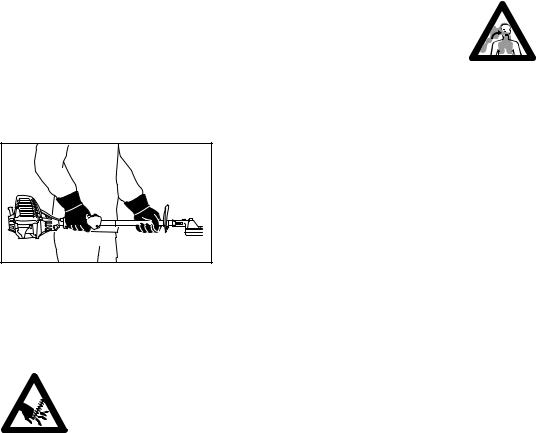
English
If you cannot set the correct idle speed, have your STIHL dealer check your power tool and make proper adjustments and repairs.
During Operation
Holding and Controlling the Power Tool
Always hold the unit firmly with both hands on the handles while you are working. Wrap your fingers and thumbs around the handles.
002BA246 KN |
Placeyourlefthandonhosegripofshaft and your right hand on rear grip and throttle trigger. This also applies to lefthanders.
 WARNING
WARNING
Never attempt to operate your power tool with one hand. Loss of control of the power tool resulting in serious or fatal injury may result. To reduce the risk
of cut injuries, keep hands and feet away from the cutting tool. Never touch a moving cutting tool with your hand or any other part of your body.
 WARNING
WARNING
Do not overreach. Keep proper footing and balance at all times. Special care mustbetakeninslipperyconditions(wet ground,snow)andindifficult,overgrown terrain.Watchforhiddenobstaclessuch as tree stumps, roots and ditches to avoidstumbling.Forbetterfooting,clear away fallen branches, scrub and cuttings. Be extremely cautious when working on slopes or uneven ground.
 WARNING
WARNING
To reduce the risk of injury from loss of control,never workon aladder,in atree or on any other insecure support. Never hold the machine above shoulder height.
Working Conditions
Operate and start your power tool only outdoors in a well-ventilated area. Operate it under good visibility and daylight conditions only. Work carefully.
8
 WARNING
WARNING
As soon as the engine is running, this product gen- erates toxic exhaust
fumes containing chemi- cals, such as unburned hydrocarbons (including benzene) and carbon monoxide, that are known to cause respira- tory problems, cancer, birth defects, or other reproductive harm. Some of the gases (e. g. carbon monoxide) may be color- less and odorless. To reduce the risk of serious or fatal injury / illness from inhaling toxic fumes, never run the machine indoors or in poorly venti- lated locations.
 WARNING
WARNING
If the vegetation being cut or the surrounding ground is coated with a chemical substance (such as an active pesticide or herbicide), read and follow the instructions and warnings that accompanied the substance at issue.
 WARNING
WARNING
Inhalation of certain dusts, especially organic dusts such as mold or pollen, can cause susceptible persons to have an allergic or asthmatic reaction.
Substantial or repeated inhalation of dustandotherairbornecontaminants,in particular those with a smaller particle size, may cause respiratory or other
HL 90 K

illnesses. Control dust at the source where possible. Use good work practices, such as operating the unit so that the wind or operating process directsanydustraisedbythepowertool away from the operator. Follow the recommendations of EPA / OSHA / NIOSH and occupational and trade associations with respect to dust ("particulate matter"). When the inhalation of dust cannot be substantially controlled, i.e., kept at or neartheambient(background)level,the operator and any bystanders should wear a respirator approved by NIOSH / MSHA for the type of dust encountered.
Operating Instructions
 WARNING
WARNING
Donotoperateyourpowertoolusingthe starting throttle lock, as you do not have control of the engine speed.
In the event of an emergency, switch off the engineimmediately– movetheslide control / stop switch to 0 or STOP.
 WARNING
WARNING
Thecutterbladescontinuetomovefora short period after the throttle trigger is released (flywheel effect).
Acceleratingtheenginewhiletheblades are blocked increases the load and will cause the clutch to slip continuously.
This may result in overheating and damage to important components (e. g. clutch, polymer housing components) – whichcanthenincreasetheriskofinjury fromthebladesmovingwhiletheengine is idling.
|
|
The power tool |
|
||
5m (17ft) |
|
has a large range. |
|
In order to reduce |
|
|
|
|
|
|
the risk of per- |
|
|
sonal or even fatal |
|
|
|
|
|
injury to bystand- |
|
|
ers from falling |
|
|
objects or inad- |
|
|
vertent contact |
|
|
with the moving |
|
|
cutter blades of |
|
|
your power tool |
|
|
always keep |
|
|
bystanders at least |
|
|
17 feet (5 m) away |
|
|
when the power |
|
|
tool is running. |
Stop the engine and cutting tool immediately if you are approached.
 WARNING
WARNING
Before you start work, examine the hedgeareaforstones,fencewire,metal or other solid objects which could damage the cutter blades.
Take particular care when cutting hedges next to or against wire fences. Do not touch the wire with the cutting blades. When working close to the ground, make sure that no sand, grit or stones get between the cutter blades.
Striking solid foreign objects such as stones, fence wire or metal could damagethecuttingattachmentandmay cause blades to crack, chip or break. STIHL does not recommend the use of your power tool when cutting in areas where the blades could contact such objects.
English
 WARNING
WARNING
Observe the cutting blades at all times – do not cut any areas of the hedge that you cannot see. When cutting the top of a taller hedge, check the other side of the hedge frequently for bystanders, animals and obstructions.
 DANGER
DANGER
Your power tool is not insulated against electric shock. To reduce the risk of electrocution, never operate this power tool in the vicinity of any wires or cables (power, etc.) which may be carrying electric current.
 WARNING
WARNING
If the cutting tool becomes clogged or stuck, always turn off the engine and make sure the cutting tool has stopped before cleaning. Grass, weeds, etc. should be cleaned off the cutting tool at regular intervals.
Checkthecuttingbladesatregularshort intervals during operation, or immediately if there is a noticeable change in cutting behavior:
–Shut off the engine.
–Wait until the cutting blades have come to a complete standstill.
–Check condition and tightness, look for cracks.
HL 90 K |
9 |
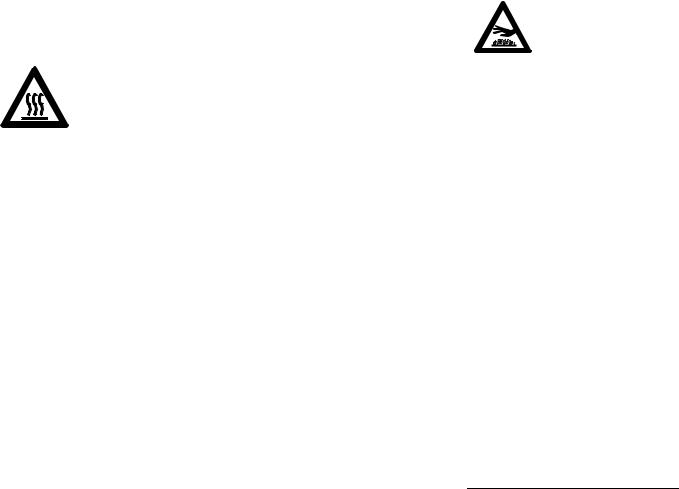
English
–Check sharpness.
–Replace damaged or dull cutting tools immediately,even if theyhave only superficial cracks.
 WARNING
WARNING
The gearbox becomes hot during operation. To reduce the risk of burn injury, do not touch the gear housing when it is hot.
 WARNING
WARNING
Never modify your muffler. Any modification could cause an increase in heat radiation, sparks or sound level, thereby increasing the risk of fire, burn injury or hearing loss. You may also permanently damage the engine. Have your muffler serviced and repaired by your STIHL servicing dealer only.
 WARNING
WARNING
Themufflerandotherpartsoftheengine (e.g. fins of the cylinder, spark plug) becomehotduringoperationandremain hot for a while after stopping the engine. Toreduceriskofburns,donottouchthe muffler and other parts while they are hot. Keep the area around the muffler clean. Remove excess lubricant and all debris such as pine needles, branches or leaves. Let the engine cool down sitting on concrete, metal, bare ground or solid wood (e.g. the trunk of a felled tree) away from any combustible substances.
 WARNING
WARNING
An improperly mounted or damaged cylinder housing or a damaged/deformed muffler shell may interfere with the cooling process of the muffler. To reduce the risk of fire or burn injury, do not continue work with a damaged or improperly mounted cylinder housing or a damaged/deformed muffler shell.
Your muffler is furnished with a spark arresting screen designed to reduce the risk of fire from the emission of hot particles. Never operate your unit with a missing or damaged spark arresting screen.Ifyourgas/oilmixratioiscorrect (i.e., not too rich), this screen will normally stay clean as a result of the heat from the muffler and need no service or maintenance. If you experiencelossofperformanceandyou suspect a clogged screen, have your muffler maintainedby aSTIHLservicing dealer. Some state or federal laws or regulations may require a properly maintained spark arrestor for certain uses.Seethe"Maintenance,Repairand Storing" section of these Safety Precautions. Remember that the risk of a brush or forest fire is greater in hot or dry conditions.
 WARNING
WARNING
Some STIHL power tools are equipped with a cata- lytic converter, which is
designed to reduce the exhaust emissions of the engine by a chemical process in the muffler. Due to this process, the muffler does not cool down as rapidly as con- ventional mufflers when the engine returns to idle or is shut off. To reduce the risk of fire and burn injuries when using a cat- alytic converter, always set your power tool down in the upright position and never locate it where the muffler is near dry brush, grass, wood chips or other combustible materi- als while it is still hot.
After Finishing Work
Always clean dust and dirt off the machine – do not use any grease solvents for this purpose.
Spray the blades with STIHL resin solvent. Start and run the engine briefly so that the solvent is evenly distributed.
MAINTENANCE, REPAIR AND STORING
Maintenance, replacement, or repair of the emission control devices and systems may be performed by any nonroad engine repair establishment or individual. However, if you make a
10 |
HL 90 K |
warranty claim for a component which has not been serviced or maintained properly or if nonapproved replacement parts were used, STIHL may deny coverage.
 WARNING
WARNING
Use only identical STIHL replacement partsformaintenanceandrepair.Useof non-STIHL parts may cause serious or fatal injury.
Strictly follow the maintenance and repair instructions in the appropriate section of your instruction manual.
Please also refer to the maintenance chart in this manual.
 WARNING
WARNING
Always stop the engine and make sure that the cutting blades are stopped before doing any maintenance or repair work or cleaning the power tool. Do not attempt any maintenance or repair work notdescribedinyourinstructionmanual. Have such work performed by your STIHL servicing dealer only.
Wear gloves when handling or performing maintenance on blades.
 WARNING
WARNING
Use the specified spark plug and make sure it and the ignition lead are always clean and in good condition. Always press spark plug boot snugly onto spark plug terminalofthe proper size. (Note: If terminal has detachable SAE adapter nut, it must be securely attached.) A loose connection between spark plug terminal and the ignition wire connector
in the boot may create arcing that could ignite combustible fumes and cause a fire.
 WARNING
WARNING
Never test the ignition system with the ignition wire boot removed from the sparkplugorwitharemovedsparkplug, since uncontained sparking may cause a fire.
 WARNING
WARNING
Do not operate your power tool if the mufflerisdamaged,missingormodified. An improperly maintained muffler will increasetheriskoffireandhearingloss. Your muffler is equipped with a sparkarresting screen to reduce the risk of fire; never operate your power tool if the screen is missing, damaged or clogged. Remember that the risk of a brush or forest fire is greater in hot or dry weather.
In California, it is a violation of § 4442 or § 4443 of the Public Resources Code to use or operate gasoline-powered tools on forest-covered, brush-covered or grass-covered land unless the engine’s exhaust system is equipped with a complying spark arrester that is maintained in effective working order. The owner/operator of this product is responsible for properly maintaining the spark arrester. Other states or governmentalentities/agencies,suchas the U.S. Forest Service, may have similar requirements. Contact your local fire agency or forest service for the laws or regulations relating to fire protection requirements.
English
 WARNING
WARNING
Never repair damaged cutting attachments by welding, straightening or modifying the shape. This may cause parts of the cutting blades to come off and result in serious or fatal injuries.
Keep the cutting blades sharp. Tighten all nuts, bolts and screws, except the carburetor adjustment screws, after each use.
Do not clean your machine with a pressure washer. The solid jet of water may damage parts of the machine.
Store the power tool in a dry and high or locked location out of reach of children.
Before storing for longer than a few days, always empty the fuel tank. See chapter "Storing the machine" in this manual.
HL 90 K |
11 |
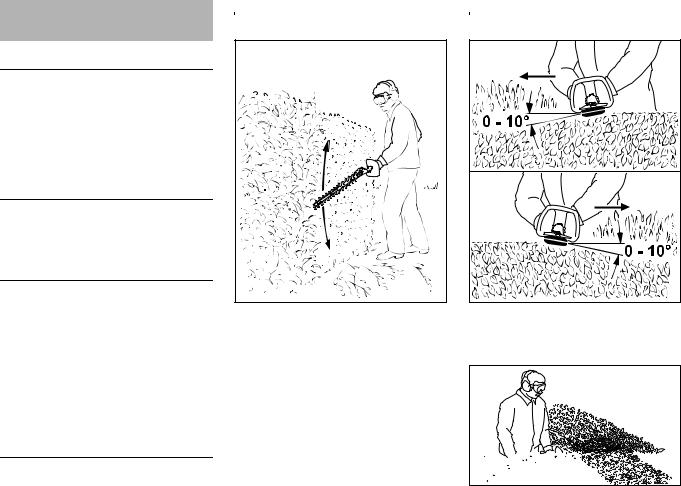
English
Using the Unit
Cutting Season
Observe country-specific or municipal rules and regulations for cutting hedges.
Do not use your hedge trimmer during rest periods cutomary in the neighborhood.
Preparations
Use lopping shears to cut out thick branches first.
Cutting Sequence
Cut the sides of the hedge first, then the top.
Ifaradical cut isnecessary,cuta littleat a time in several stages.
Recommendation:
Only cut hedges that are no more than chest height.
Disposal
Do not throw cuttings into the garbage can – they can be composted!
Vertical cut |
|
Horizontal cut |
445BA001 KN |
Swing the cutter bar up and down in an arc as you move along the hedge – use both sides of the cutting blades.
Any working position above head height is tiring. To minimize the risk of accidents, work in such positions for short periods only.
445BA007 KN |
Hold the cutter bar at an angle of 0° to 10° as you swing the hedge trimmer horizontally.



























































 445BA002 KN
445BA002 KN
Swing the cutter bar in an arc towards the outside of the hedge so that the cuttings are swept to the ground.
12 |
HL 90 K |
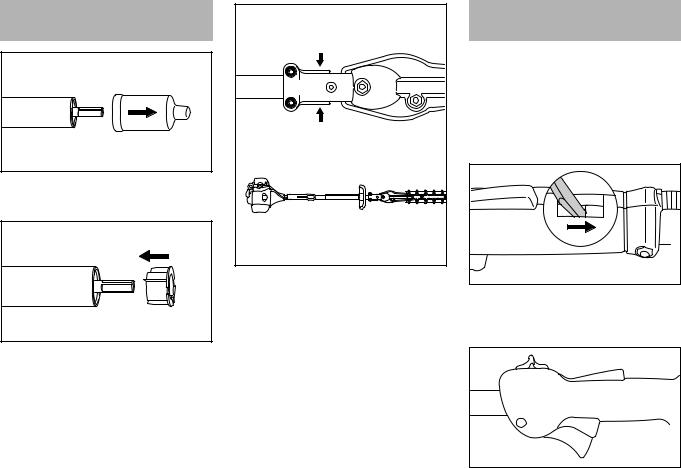
Mounting the Gearbox
413BA014 KN |
NPull theprotectivecap offtheendof the drive tube.
002BA248 KN |
The plug maycomeout of thedrive tube when you pull off the cap. Push it back into the drive tube as far as stop.
|
1 |
3 |
2 |
|
1 |
|
445BA003 KN |
N Loosen the clamp screws (1).
NPush the gearbox (2) onto the drive tube (3) – turn it back and forth at the same time until the end of the drive tube is no longer visible in the slot (arrow) – then push fully home as far as stop.
NLine up the gearbox on the drive tubesothatthemachinesupporton the engine points down and the blades are horizontal.
NTighten down the clamp screws (1) firmly.
English
Adjusting the Throttle Cable
A properly adjusted throttle cable is the precondition for correct operation in the full throttle, starting throttle and idle positions.
NAdjust the throttle cable only when the unit is completely and properly assembled.
002BA163 KN
NUse a suitable tool to push the slide to the end of the slot (see illustration).
1
|
KN |
2 |
002BA161 |
|
NPress down the throttle trigger lockout (1) and squeeze the throttle trigger (2) (full throttle) – this sets the throttle cable correctly.
HL 90 K |
13 |

English
4-MIX Engine
The STIHL 4-MIX engine features mixture lubricationandmustbe runon a fuel mixture of gasoline and engine oil.
It operates otherwise on the 4-stroke principle.
Fuel
This engine is certified to operate on unleaded gasoline and the STIHL twostroke engine oil at a mix ratio of 50:1.
Your engine requires a mixture of highquality gasoline and two-stroke air cooled engine oil.
Usemid-gradeunleadedgasolinewitha minimum octane rating of 89 ((R+M)/2) and no more than 10% ethanol content.
Fuel with a lower octane rating may increase engine temperatures. This, in turn, increases the risk of piston seizure and damage to the engine.
The chemical composition of the fuel is also important. Some fuel additives not only detrimentally affect elastomers (carburetor diaphragms, oil seals, fuel lines,etc.),butmagnesiumcastingsand catalytic converters as well. This could cause running problems or even damage the engine. For this reason STIHL recommends that you use only high-quality unleaded gasoline!
Gasoline with an ethanol content of more than 10% can cause running problems and major damage in engines with a manually adjustable carburetor and should not be used in such engines.
The ethanol content in gasoline affects engine running speed – it may be necessary to readjust the carburetor if you use fuels with various ethanol contents.
 WARNING
WARNING
To reduce the risk of personal injury from loss of control and / or contact with the running cutting tool, do not use your unit with incorrect idle adjustment. At correct idle speed, the cutting tool should not move.
Ifyourpowertoolshowsanincorrectidle adjustment, have your STIHL dealer check your power tool and make proper adjustments and repairs.
The idle speed and maximum speed of the engine change if you switch from a fuel with a certain ethanol content to another fuel with a much higher or lower ethanol content.
This problem can be avoided by always using fuel with the same ethanol content.
Use STIHL HP Ultra oil or ask your dealer for an equivalent high quality oil to ensure the maximum performance of the product for the full lifetime.
To meet the requirements of EPA 40CFR90/1054 we recommend to use STIHL HP Ultra oil.
Do not use BIA or TCW rated (twostroke water cooled) mix oils or other mixoilsthatstatetheyareforuseinboth water cooled and air cooled engines (e.g., outboard motors, snowmobiles, chain saws, mopeds, etc.).
Take care when handling gasoline. Avoid direct contact with the skin and avoid inhaling fuel vapor. When filling at the pump, first remove the container from your vehicle and place the containeronthegroundbeforefilling.To reduce the risk of sparks from static
14 |
HL 90 K |
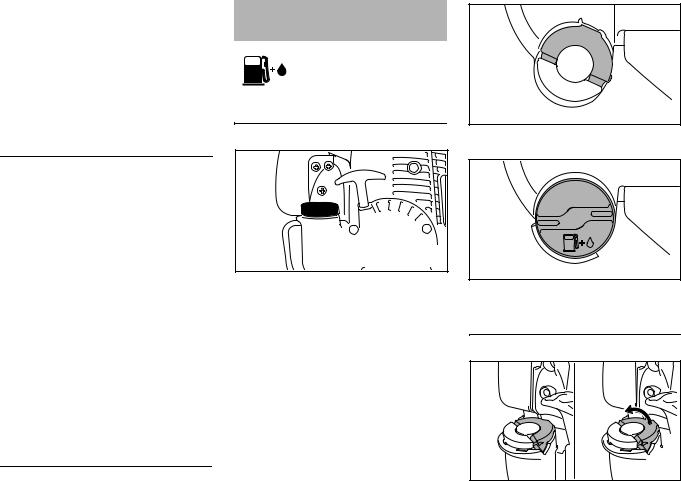
discharge and resulting fire and/or explosion, do not fill fuel containers that are sitting in or on a vehicle or trailer.
The container should be kept tightly closed in order to limit the amount of moisture that gets into the mixture.
The machine’s fuel tank should be cleaned as necessary.
Fuel mix ages
Only mix sufficient fuel for a few days work,nottoexceed3monthsofstorage. Store in approved fuel-containers only. When mixing, pour oil into the container first, and then add gasoline. Close the container and shake it vigorously by hand to ensure proper mixing of the oil with the fuel.
Gasoline |
Oil (STIHL 50:1 or equiva- |
|
|
lent high-quality oils) |
|
Liters |
Liters |
(ml) |
1 |
0.02 |
(20) |
5 |
0.10 |
(100) |
10 |
0.20 |
(200) |
20 |
0.40 |
(400) |
US gal. |
US fl.oz. |
|
12.6
2 1/2 |
6.4 |
512.8
Dispose of empty mixing-oil containers only at authorized disposal locations.
Fueling
Preparations




 002BA420 KN
002BA420 KN
NBefore fueling, clean the filler cap andtheareaaroundittoensurethat no dirt falls into the tank.
Always thoroughly shake the mixture in the canister before fueling your machine.
NPosition the machine so that the filler cap is facing up.
 WARNING
WARNING
In order to reduce the risk of fire and personalinjuryfromescapinggasvapor and fumes, remove the fuel filler cap carefully so as to allow any pressure build-up in the tank to release slowly.
One of two different filler caps is installed as standard at the factory.
English
002BA418 KN
Toolless filler cap (with folding grip)
002BA419 KN
Threaded filler cap
Opening the toolless filler cap

 249BA053 KN
249BA053 KN
NSwing the grip into an upright position.
HL 90 K |
15 |

English

 249BA054 KN
249BA054 KN
NTurn the cap counterclockwise (approx. 1/4 turn).
N Remove the filler cap.
Refueling
Take care not to spill fuel while fueling, and do not overfill the tank. STIHL recommends use of the STIHL filling system (special accessory).
Closing the toolless filler cap






 249BA055 KN
249BA055 KN
NPosition the cap with the grip in an upright position; the raised positioning marks must line up.
NTurn cap clockwise as far as it will go (approx. 1/4 turn).
16







 249BA056 KN
249BA056 KN
NFold the grip down so that it is flush with the surface.
If the grip is not flush with the surface and the lug on the clip does not engage entirely in the recess (arrow), the cap is not properly closed and the steps describedabovemustberepeated.See also the "Toolless cap with grip" section in the Safety Precautions.
Opening the threaded filler cap
Closing the threaded filler cap
002BA448 KN |
N Position cap.
NTurn the cap clockwise as far as it will go and tighten it as securely as possible by hand.
002BA447 KN |
NTurn the cap counterclockwise until it can be removed from the tank opening.
N Remove the filler cap.
Refueling
Take care not to spill fuel while fueling and do not overfill the tank. STIHL recommends use of the STIHL filling system (special accessory).
HL 90 K
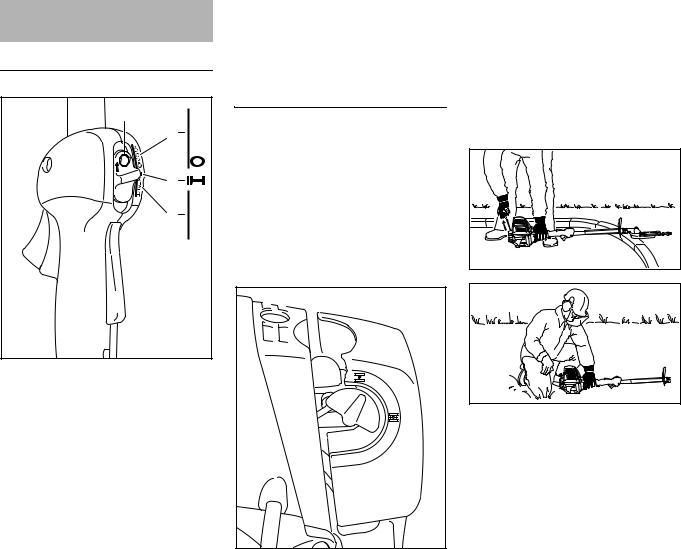
Starting / Stopping the
Engine
Controls
7 |
|
-STOP |
|
4 |
|
|
|
|
STOP |
|
|
3 |
5 |
START |
|
||
|
6 |
|
|
|
2
1
002BA181 KN
1 Throttle trigger lockout
2 Throttle trigger
3Slide control
Positions of slide control
4STOP-0– engineoff–the ignitionis switched off
5F– normal run position – the engine is running or can start
6START – the ignition is switched on
– the engine can start
Symbol on slide control
7h– stop symbol and arrow. To stop the engine, push the slide control in thedirectionofthearrowonthestop symbol (h) to STOP-0.
Starting the Engine
NPressdownthetriggerlockoutlever and squeeze the throttle trigger.
N Hold both levers in this position.
NMove the slide control to START and hold it there.
NNow release the throttle trigger, slide control and trigger lockout in that order. This is the starting throttle position.
English
g If the engine is cold
efor warm start – also use this posi- tion if the engine has been running but is still cold.
NPressthefuelpumpbulb (9)atleast five times – even if the bulb is already filled with fuel.
Starting |
445BA004 KN |
9 |
KN |
|
445BA005 |
||
|
||
8 |
N Placetheunitontheground:Itmust |
|
|
rest securely on the engine support |
|
|
and the gearbox. |
|
|
N Removethebladescabbard.Check |
|
|
that the cutting blades are not |
|
KN |
touching the ground of any other |
|
obstacles. If necessary, rest the |
||
249BA057 |
mound, brick or something similar). |
|
|
gearbox on a raised support (e.g. |
|
N Set the choke knob (8): |
N Make sure you have a firm footing. |
|
N Holdthe unitwithyourlefthandand |
||
|
||
|
press it down firmly – your thumb |
|
|
should be under the fan housing. |
HL 90 K |
17 |

English
NOTICE
Do not stand or kneel on the drive tube since it will otherwise be permanently bent and damaged.
NPull the starter grip slowly with your right hand until you feel it engage and then give it a brisk strong pull.
NOTICE
Do not pull out the starter rope all the way – it might otherwise break.
NDonotletthestartergripsnapback. Guideitslowlybackintothehousing so that the starter rope can rewind properly.
NContinue cranking until the engine fires.
When the engine begins to fire or after no more than five pulls:
N Turn the choke knob to e N Continue cranking.
As soon as the engine runs
NBlip the throttle trigger. The slide control moves to the normal run position F– and the engine settles down to idle speed.
Make sure the carburetor is correctly adjusted. The cutting blades must not move when the engine is idling.
Your machine is now ready for operation.
Shut off the engine |
If the engine still does not start: |
NPush the slide control in the direction of the arrow on the stop symbol (h) to STOP-0.
Other hints on starting
At very low outside temperatures As soon as the engine runs:
NBlip the throttle trigger to disengage the starting throttle position. The slide control moves to the normal run position F– and the engine settles down to idle speed.
N Open the throttle slightly. N Warm up the engine briefly.
If the engine does not start
If you did not turn the choke knob to e quicklyenoughaftertheenginebeganto fire, the combustion chamber is flooded.
N Turn the choke knob to e
NSettheslidecontrol,Throttletrigger lockout lever and throttle trigger to the starting throttle position.
NStart the engine by pulling the starter rope briskly – 10 to 20 pulls may be necessary.
 10
10 







 KN249BA058
KN249BA058
N Move the slide control to STOP-0. N Pull off the spark plug boot (10). N Unscrew and dry off the spark plug. N Open the throttle wide.
NCranktheengineseveral timeswith the starter to clear the combustion chamber.
N Refit the spark plug.
NConnect the spark plug boot (press it down firmly).
N Move the slide control to START.
NSet the choke knob to e– even if the engine is cold.
N Now start the engine.
Throttle cable adjustment
NCheckadjustmentofthrottlecable– see chapter on "Adjusting the Throttle Cable".
18 |
HL 90 K |
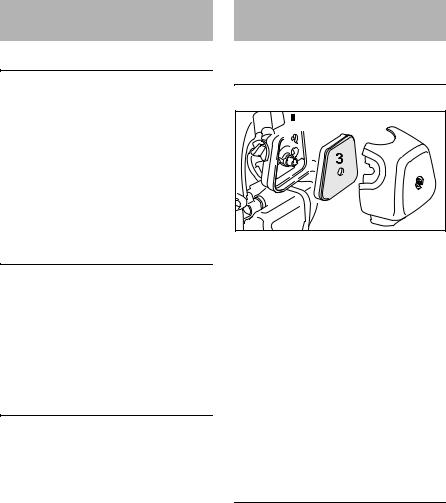
If fuel tank has been run completely dry and then refueled
NPress the fuel pump bulb at least five times – even if the bulb is filled with fuel.
NSet the choke knob according to engine temperature.
N Now start the engine.
Operating Instructions
During break-in period
A factory-new machine should not be run at high revs (full throttle off load) for the first three tank fillings. This avoids unnecessary high loads during the break-in period. As all moving parts have to bed in during the break-in period, the frictional resistances in the engine are greater during this period. The engine develops its maximum power after about 5 to 15 tank fillings.
During Operation
After a long period of full throttle operation, allow the engine to run for a short while at idle speed so that engine heat can be dissipated by the flow of cooling air. This protects enginemounted components (ignition, carburetor) from thermal overload.
After Finishing Work
Storing for a short period: Wait for the enginetocooldown.Emptythefueltank and keep the machine in a dry place, well away from sources of ignition, until you need it again. For longer out-of- service periods – see "Storing the Machine".
English
Cleaning the Air Filter
If there is a noticeable loss of engine power


 4
4
|
1 |
|
2 |
KN |
|
273BA006 |
||
|
N Turn the choke knob to g
NTake out the screw (1) and remove the filter cover (2).
NClean away loose dirt from around the filter.
NGrip the filter element (3) at the cutout (arrow) in the filter housing (4) and remove it.
NFit a new filter element. As a temporarymeasureyoucanknockit outonthepalmofyourhandorblow it out with compressed air. Do not wash.
N Replace damaged parts.
Installing the filter
NInstall the filter element in the filter housing and fit the cover.
NInsert the screw and tighten it down firmly.
HL 90 K |
19 |
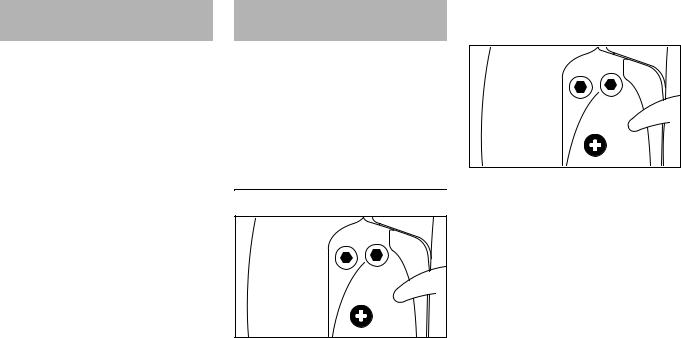
English
Engine Management
Exhaust emissions are controlled by the design of the fundamental engine parameters and components (e.g. carburation, ignition, timing and valve or port timing) without the addition of any major hardware.
Adjusting the Carburetor
The carburetor comes from the factory with a standard setting.
Thissettingprovidesanoptimumfuel-air mixture under most operating conditions.
These power tools are equipped with different carburetors:
Version A
H L |
|
|
KN |
LA |
249BA066 |
|
–High speed screw and low speed screw with special head – without slotted head.
On these machine versions it is no longer necessary to adjust the carburetor.
These machines have been set at the factory to provide an optimum fuel-air mixture in all locations and operating conditions.
Adjusting Idle Speed
Engine stops while idling
H L |
|
|
KN |
LA |
249BA066 |
|
NWarm up the engine for about 3 minutes.
NTurn the idle speed screw (LA) slowly clockwise until the engine runs smoothly – the cutting blades must not run.
Cutting blades run when engine is idling
NTurn the idle speed screw (LA) counterclockwise until the cutting blades stop running and then turn the screw about another 1/2 to 3/4 turn in the same direction.
 WARNING
WARNING
If the cutting blades continue moving when the engine is idling, have your powertoolcheckedandrepairedbyyour servicing dealer.
20 |
HL 90 K |
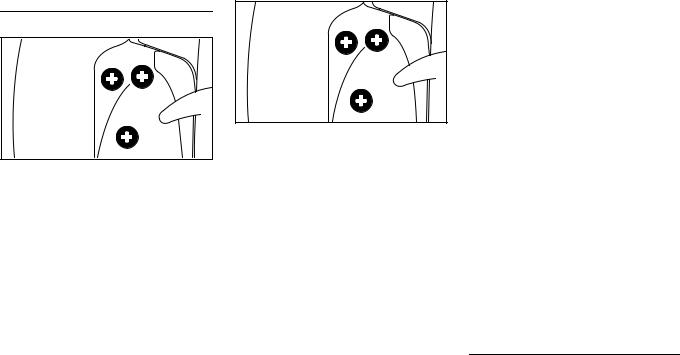
Version B
H L |
|
|
KN |
LA |
249BA067 |
|
–High speed screw and low speed screw with slotted head.
With this carburetor it is only possible to adjust the high speed and low speed screws within fine limits.
Standard Setting
N Shut off the engine
NInspectthecuttingbladesandclean if necessary (they must be clean, move freely and not be warped).
NCheck the air filter and clean or replace as necessary.
NCheck that the throttle cable is properly adjusted – readjust if necessary – see chapter on "Adjusting the Throttle Cable".
NCheck the spark arresting screen (not in all versions) and clean or replace as necessary.
H L |
|
|
KN |
LA |
249BA067 |
|
NCarefullyturnbothadjustingscrews counterclockwise as far as stop:
–Thehighspeedscrew(H)is3/4turn open.
–The low speed screw (L) is 3/4 turn open.
N Start and warm up the engine.
NAdjustidlespeedwiththeidlespeed screw(LA)sothatthecuttingblades do not run.
Adjusting Idle Speed
It is usually necessary to change the settingoftheidlespeedscrew(LA)after every correction to the low speed screw
(L).
NWarm up the engine for about 3 minutes.
Engine stops while idling
NTurn the idle speed screw (LA) slowly clockwise until the engine runs smoothly – the cutting blades must not run.
Cutting blades run when engine is idling
NTurn the idle speed screw (LA) counterclockwise until the cutting blades stop running and then turn the screw about another 1/2 to 3/4 turn in the same direction.
English
 WARNING
WARNING
If the cutting blades continue moving when the engine is idling, have your powertoolcheckedandrepairedbyyour servicing dealer.
Erratic idling behavior, engine stops even though setting of LA-screw has been corrected, poor acceleration
Idle setting is too lean:
NTurn the low speed screw (L) counterclockwise, no further than stop, until the engine runs and accelerates smoothly.
Erratic idling behavior
Idle setting is too rich
NTurn the low speed screw (L) clockwise,nofurtherthanstop,until the engine runs and accelerates smoothly.
Version B: Fine Tuning
A slight correction of the setting of the highspeedscrew(H)maybenecessary if engine power is not satisfactory when operating at high altitude or at sea level.
Rule of thumb:
Turn the high speed screw (H) about one quarter turn for every 1000m (3300 ft) change in altitude.
HL 90 K |
21 |
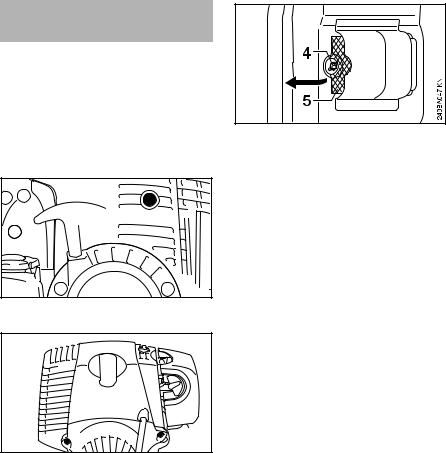
English
Conditions for adjustment
NCarry out the standard setting without disturbing the high speed screw (H).
NWarm up the engine for about 3 minutes.
N Open the throttle wide.
At high altitude
NTurn the high speed screw (H) clockwise (leaner), no further than stop, until there is no further noticeable increase in engine speed.
At sea level
NTurn the high speed screw (H) counterclockwise(richer),nofurther than stop, until there is no noticeable increase in engine speed.
It is possible that maximum engine speedmaybereachedwiththestandard setting.
Spark Arresting Screen in
Muffler
In some countries the muffler is equipped with a spark arresting screen.
NIf the engine is down on power, check the spark arresting screen in the muffler.
N Wait for the muffler to cool down. N Move the slide control to STOP-0.

 1
1 




 249BA059 KN
249BA059 KN
N Take out the screw (1).
|
3 |
249BA060 KN |
2 |
2 |
NTakeoutthescrews (2)andremove the shroud (3).
N Take out the screw (4).
NLift the spark arresting screen (5) and pull it out.
NClean the spark arresting screen. If the screen is damaged or heavily carbonized, fit a new one.
N Refit the spark arresting screen.
NInsert the screw and tighten it down firmly.
N Fit the shroud.
22 |
HL 90 K |
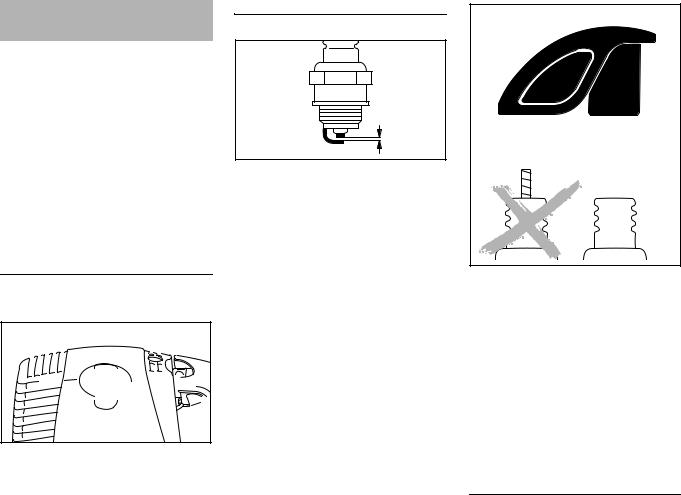
Spark Plug
If engine is down on power, difficult to start or runs poorly at idling speed, first check the spark plug.
Fit a new spark plug after approx. 100 operating hours or earlier if the electrodes are badly eroded.
Wrong fuel mix (too much engine oil in the gasoline), a dirty air filter and unfavorable running conditions (mostly at part throttle etc.) affect the condition of the spark plug. These factors cause deposits to form on the insulator nose which may result in trouble in operation.
Removing the spark plug
N Move the slide control to STOP-0.
 1
1 







 KN249BA063
KN249BA063
N Pull off the spark plug boot (1). N Unscrew the spark plug.
Checking the Spark Plug
|
KN |
A |
000BA039 |
|
N Clean dirty spark plug.
NCheck electrode gap (A) and readjust if necessary – see "Specifications".
NUseonlyresistortypesparkplugsof the approved range.
Rectify problems which have caused fouling of spark plug:
–Too much oil in fuel mix.
–Dirty air filter.
–Unfavorable running conditions, e.g. operating at part load.
English
 2
2
002BA363 KN
 WARNING
WARNING
Toreducetheriskoffireandburninjury, use only spark plugs authorized by STIHL.Alwayspresssparkplugboot(1) snuglyontosparkplugterminal(2)ofthe proper size. (Note: If terminal has detachable SAE adapter nut, it must be attached.) A loose connection between spark plug boot and ignition wire connector in the boot may create arcing that could ignite combustible fumes and cause a fire.
Installing the spark plug
NScrew home the spark plug, fit the boot and press it down firmly.
HL 90 K |
23 |
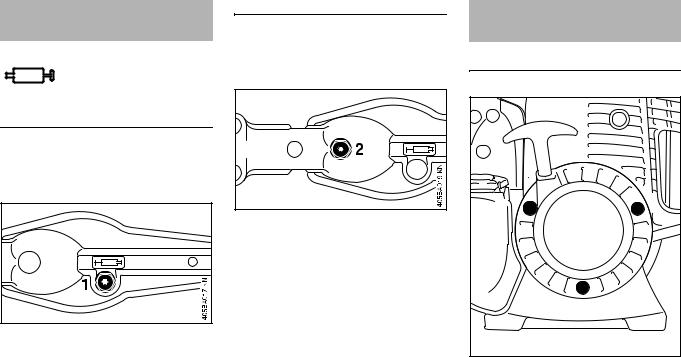
English
Lubricating the Gearbox
Blade drive gear
Lubricate the blade drive gear with STIHLgearlubricantforhedgetrimmers
– see "Special Accessories".
NCheck the lubricant level regularly, about every 25 hours of operation. Unscrew the filler plug (1).
NScrew the tube of grease into the filler hole.
NSqueeze up to 1/5 oz (5 g) grease into the gearbox.
NOTICE
Do not completely fill the gearbox with grease.
NUnscrewthetubeofgreasefromthe filler hole.
NRefit the filler plug and tighten it down firmly.
Angle drive
Lubricate the angle drive with STIHL gear lubricant for brushcutters – see "Special Accessories".
NCheck the lubricant level at regular intervals of about every 25 hours of operation. Unscrew the filler
plug (2) – if no grease can be seen on the inside of the filler plug, screw thetubeofgreaseintothefillerhole.
NSqueeze up to 1/5 oz (5 g) grease into the gearbox.
NOTICE
Do not completely fill the gearbox with grease.
NUnscrewthetubeofgreasefromthe filler hole.
NRefit the filler plug and tighten it down firmly.
Replacing the Starter Rope
and Rewind Spring
Replacing the Starter Rope
1 |
1 |
2 |
|
1 |
KN |
|
249BA061 |
NPush the slide control in direction of arrow h– to STOP-0.
N Take out the screws (1).
NRemove the starter cover (2) from the housing.
24 |
HL 90 K |
